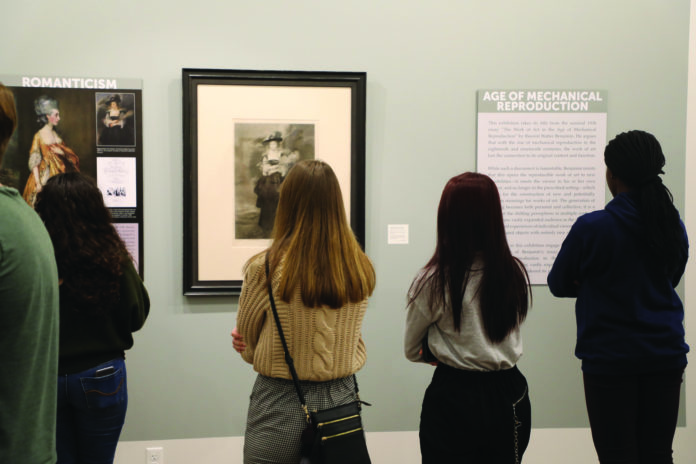
By Carson Lewis | Page One Editor
“The Age of Mechanical Reproduction,” an exhibit housing artwork accompanied by student research, is open to the public in the Martin Museum of Art once more after originally being shown in fall 2017.
“This is only the second time it has ever been shown. We showed it initially in 2017 at the end of the semester. We had a symposium for [the students] to present their original findings, and we decided to rehang the exhibition now because we like it,” museum director Allison Chew said.
After opening on Tuesday, the exhibit will stay available for the public to visit until Nov. 10.
Covered in the exhibit are 18th and 19th century prints depicting flora and fauna, pre-industrial royal tournaments and self-portraits, among others. All pieces were selected by students and faculty from the Martin Museum collection and were researched and analyzed within the class before being put on display.
The exhibit takes its name from a 1936 essay by German philosopher Walter Benjamin titled “The Work of Art in the Age of Mechanical Reproduction.” In the essay, Benjamin claims that art changed with the advent of “mechanical reproduction,” or the ability for art to become mass-produced.
To illustrate this, one lithograph in the exhibit, 1865’s “American Autumn Fruits” depicts a variety of fruits centralized around a translucent glass dish. While seemingly ordinary on its surface, the piece was originally printed without the intense colors of the art displayed in the museum. After printing, workers would be tasked with painting a specific color onto the art. This process allowed for the piece to be produced on a larger scale than if only a single artist were to color it.
A catalogue of the exhibit said that the works displayed show an engagement and development of Benjamin’s essay.
“This critical shift occurred partially as a result of the new printing technologies and radical social changes of the 18th and 19th centuries. While the preceding century saw incredibly refined engravings with only limited circulation among elite collectors, the 18th century witnessed a vast expansion in media and audience,” the catalogue said.
All pieces within the exhibit were originally presented by students in Dr. Sean DeLouche’s 2017 class. Students chose their own art from a database, originally picking five to six pieces they found interesting. Those pieces were then taken from Martin Museum storage to the classroom, where students could further inspect the pieces with gloves before choosing one for research.
Gallery attendant Elisa Crowder said that this kind of study during undergraduate education is rare.
“Most students do not get to study and research a piece of art up-close until they’re in graduate school, so this was a really big deal,” Crowder said.
Chew said that the exhibit is unique because the information on every piece displayed has been enhanced by the work put in by the student researchers.
“This is the fruits of their labor — the exhibition is kind of the culmination of all the research they did. The research is original research, so they presented new ideas about the work,” Chew said.
The Martin Museum is open between 10 a.m. to 5 p.m. Tuesday through Saturday and 1 p.m. to 5 p.m. Sunday; the museum is closed Mondays.
Chew said that the exhibition “[is] a great show, and it’s a great way to showcase the relationship we have with the department [of art and art history].”





